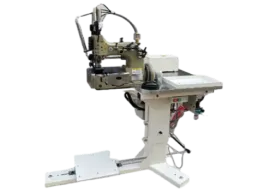serger and coverstitch machine
Understanding Sergers and Coverstitch Machines Essential Tools for Modern Sewing
In the world of sewing, two machines stand out for their unique capabilities and the specialized finishes they provide the serger and the coverstitch machine. While both are used in conjunction with regular sewing machines, they each offer distinct functions that can elevate your sewing projects to a professional level. Understanding these machines is critical for anyone looking to enhance their sewing skills, whether a beginner or an experienced seamstress.
What is a Serger?
A serger, also known as an overlock machine, is designed to trim the seam allowances of a fabric while simultaneously sewing over the raw edges. This dual-action process not only provides a neat finish but also helps prevent fraying, which is particularly advantageous for fabrics like knits and delicate materials. Typically, a serger uses multiple threads—usually three or four—to create a strong, stretchy seam that can withstand the stresses of wear and tear.
Serger machines are particularly favored for their speed; they can sew and finish edges in a single step. This efficiency is a game-changer for large projects or when working with intricate patterns. Additionally, many sergers come equipped with differential feed mechanisms that adjust the fabric feeding, preventing stretching or puckering, making them ideal for sewing stretchy fabrics and ensuring a polished look.
What is a Coverstitch Machine?
While sergers excel at finishing raw edges, a coverstitch machine specializes in creating finishes that are typically seen on ready-to-wear garments, such as hems and neckbands. This machine features a different setup, usually using two needles and a looper, allowing it to sew two lines of stitching on the top while forming a chain stitch on the underside. The result is a professional-looking hem that is both durable and stretchy, essential for garments made from knit fabrics.
serger and coverstitch machine

Coverstitch machines are particularly beneficial for garment finishing tasks—especially for t-shirts, leggings, and other stretchy apparel. They provide the flexibility required in fitted clothing while ensuring that the hems lay flat and comfortably against the skin. Additionally, some coverstitch machines can handle a variety of fabric weights, making them versatile for various sewing projects.
The Synergy Between Both Machines
While both sergers and coverstitch machines serve unique purposes, they can be used in tandem to produce stunning results in your sewing projects. A common workflow involves using a serger to finish the raw edges of fabric pieces before stitching them together. After assembling the garment, the coverstitch machine provides that polished finish on hems and armholes.
This combination not only enhances the durability and aesthetics of your garments but also speeds up the sewing process significantly, allowing for professional-quality results at home. For those looking to invest in both machines, it's important to consider the types of projects you’ll be working on and how frequently you will use each machine.
Conclusion
In conclusion, incorporating a serger and a coverstitch machine into your sewing arsenal can significantly elevate your craftsmanship. These machines offer unparalleled efficiency and finishing options that can transform ordinary garments into high-quality, professional pieces. Whether you are a hobbyist or a seasoned professional, understanding the functionalities of each machine will empower you to make informed decisions, ensuring that your sewing projects are not only beautiful but also durable and functional. Embrace the power of these tools and watch your sewing journey flourish!
-
Industrial Cylinder Arm Sewing Machine: Revolutionizing Heavy-Duty SewingNewsJul.28,2025
-
Cylinder Arm Sewing Machine: Perfect for Special Sewing ApplicationsNewsJul.28,2025
-
Cylinder Bed Sewing Machine: Essential for Sewing Complex MaterialsNewsJul.28,2025
-
Heavy Duty Sewing Machine: The Essential Tool for Industrial ApplicationsNewsJul.28,2025
-
Computerized Pattern Sewing Machine: Revolutionizing Precision StitchingNewsJul.28,2025
-
Heavy Duty Industrial Sewing Machine: Power Meets PrecisionNewsJul.28,2025
-
Leather Sewing Machine: The Industrial Standard for Tough MaterialsNewsJul.18,2025





























